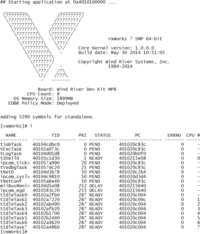
Photo from wikipedia
Monitoring of brain pressure is considered to be of major importance for the optimum treatment of various neurosurgical diseases. Quite recently, several devices for telemetric brain pressure monitoring became available… Click to show full abstract
Monitoring of brain pressure is considered to be of major importance for the optimum treatment of various neurosurgical diseases. Quite recently, several devices for telemetric brain pressure monitoring became available for clinical application. The advantage of telemetric ICP monitoring in comparison with conventional ICP monitoring, besides a lower infection rate due to the closed system used, is the possibility to record the ICP within greater time intervals, at any time and for longer periods [1–8, 12]. Most commonly, telemetric long-term measurement is used for monitoring and controlling patients with acute neurosurgical conditions such as severe head trauma, after neuroendoscopic procedures or implantation of cerebral shunts, verifying subtle shunt dysfunction especially underor overdrainage and for optimization of shunt valve settings [1–4, 7, 8, 10, 11]. Tschan et al. described a new technique for long-term home telemetric ICP monitoring by receiving the home telemonitoring data from the patients online as well as using Internet consultations. Since the introduction of the Raumedic Helmbrecht p-Tel device in 2009, there were several descriptions of domestic use [1, 3]. This study, however, presents for the first time a detailed description of a bigger cohort, namely 20 patients using home telemetric ICP monitoring. Additionally, the authors established a method for real home telemonitoring. With enabling the patients to send their encoded ICP records via the Internet, they could overcome the limited storage capacity of the datalogger (72 h). An accompanying online consultation was included in the home telemonitoring service. That was how the authors achieved to avoid unnecessary outpatient visits, especially advantageous for patients living further away from a specialized neurosurgical center. However, obviously, this technique also has limitations. If neurosurgical intervention of any kind (including a simple valve adjustment) is necessary, this can only be done in a clinical setting since online valve adjustment is not possible yet, even though techniques using online programmable valves may be available in the future. Another more profane disadvantage is the limited availability of a sufficient quantity of datalogger systems for providing long-term home telemonitoring over weeks since this system was not designed for home monitoring. Due to the high expenses of these devices, they cannot be given to the patients on a regular basis. At first glance, home telemetric measurements could exploit the advantage of telemetric ICP monitoring at the most. Especially for the detection and consecutive therapy of overdrainage, this method seems to be effective because it allows recording and evaluation of the ICP in orthostasis under daily circumstances in an environment which the patient is used to as the patients’ activity at home is usually much higher compared with that during a hospital stay. Furthermore, in a home setting, the effect of valve adjustment if it was needed can be observed much more adequately. However, since the introduction of the Sensor Reservoir by Miethke Company in 2015, there is another telemetric ICP system available for verification of subtle drainage-related shunt failure and controlling and optimizing valve setting adjustment [4, 7]. Opposite to the p-Tel probe which has to be explanted after 3 months, the shunt sensor does not have to be explanted. It is integrated into the shunt system and is permitted for an unlimited implantation time [4]. Despite data which shows the p-Tel probe provided reliable measurements beyond the approved implantation time of 90 days [9, 11], the advantage of the longer duration of the shunt sensor is obvious. This article is part of the Topical Collection on CSF Circulation
Journal Title: Acta Neurochirurgica
Year Published: 2019
Link to full text (if available)
Share on Social Media: Sign Up to like & get
recommendations!